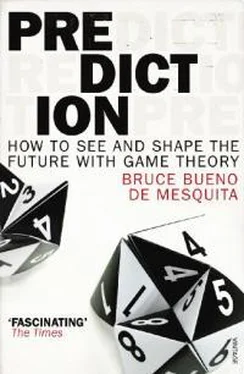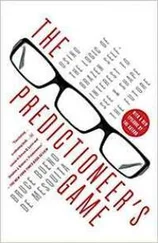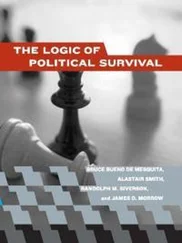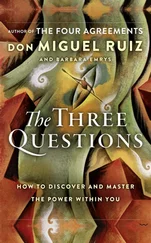Time inconsistency problems arise in many contexts, not just land for peace or peace for land. In fact, we saw an example of this problem earlier when we discussed North Korea. The threat of reneging on promises once an adversary has disarmed is exactly why asking Kim Jong Il to dismantle his nuclear capability won’t work, but negotiating a deal in which he agrees to disable his nuclear program can work. The problem is no less consequential in the Middle East.
Look at the decision by Israel’s hard-liner prime minister Ariel Sharon to withdraw (unilaterally) from Gaza in August 2005, ceding that territory to the Palestinians. An important part of Sharon’s motivation seems to be that he concluded it was too costly to defend Gaza. So he chose to make Israeli settlers abandon their homes, whose existence was a major flashpoint with Palestinians, in the hope that yielding Gaza would help promote goodwill and peace. The belief that good deeds, whatever their motivation, will elicit a good response reflects optimism about human nature that sometimes is met by reality but all too often is met instead with greed and aggression. As you know, game theory rarely takes an optimistic view of human nature. Sharon’s optimism was predictably wrong. Shortly after the democratically elected government run by Hamas in the Palestinian Authority used force to oust Palestinian president Mahmoud Abbas’s Fatah from Gaza, Hamas increased missile attacks against Israeli towns near the Gaza border. Land, freely given with no strings attached, did not produce peace. It produced a demand for more land and an increase in violence.
Mind you, this failure on behalf of the pursuit of peace is not some particular flaw among Palestinians. The Israelis have done much the same in the past. Having defeated their Arab rivals in the 1967 war and then again in 1973, Israel not only occupied previously controlled Egyptian, Syrian, Jordanian, and Palestinian land but also allowed the spread of settlements presumptively justified by the biblical covenant between Abraham and God. In fact, Israeli settlements almost always occupy the high ground surrounding Palestinian villages, making it all but impossible for Palestinians to enjoy a sense of security within their own homes. And even more troubling, Israel for decades restricted the movement of Palestinians into and out of Israel, just as they had done within Israel to Israeli citizens of Palestinian extraction. The upshot is that the Israeli government prevented Palestinians from following a peaceful road to independence by restricting their freedom of assembly. When Israel had the opportunity to promote peace with Palestinians after the 1967 war, it fell short, just as the Palestinians have fallen short in efforts to promote peace with the Israelis.
Every land-for-peace and peace-for-land formula I know of has ended in failure. Every such effort, whether unilateral, bilateral, or multilateral, has, if anything, made the situation worse by raising false hopes only to see them dashed. They are always dashed because the peacemakers simply do not pay attention to the time inconsistency in their strategy. They rely on goodwill and building trust when there is neither. Instead, they should leverage progress toward peace on the narrow self-interest of the contending sides. They should consider whether what they propose is a self-enforcing strategy from which no one has an incentive to deviate, rather than looking for an approach that requires mutual cooperation. Remember the prisoner’s dilemma from Chapter 3? Both players in that game are better off if they coordinate with each other to pursue joint cooperation instead of ending up competing with one another. The problem is that each is even better off by not cooperating if the other player chooses to cooperate. The upshot is that neither cooperates, leaving both worse off than they could have been. That, in fact, is the dilemma. Like the Israeli-Palestinian dispute, joint cooperation is not a sustainable solution unless the structure of the game changes first.
One way to change the game is to make costs and benefits change directly and automatically in response to the actions chosen by each player. A self-enforcing strategy solves this problem and can help promote peace and prosperity for each side. Here I would like to use the power of game-theory thinking to propose an important step toward peace between Palestinians and Israelis. It is not a comprehensive peace plan, but it is a way to make peace more likely. What I will say follows logically from game-theory reasoning, but it is not a mere assessment of what is likely to happen. It is a statement of logic in support of a way to end violence. It is a prescription for progress.
Key to my proposal is the phrase “self-enforcing.” It is an arrangement that requires little or no cooperation or trust between Israelis and Palestinians. The idea I have in mind provides each side with incentives to promote peace and resist terrorism purely in their own interest and utterly without concern for whether it helps the other side. In that sense it follows game theory’s dismal view of human nature.
My idea is that the Israeli and Palestinian governments will distribute a portion of their tax revenue generated from tourism (and only from tourism) to each other. Before going into the details—where the devil resides—let’s first see why tourist revenue and not any other. Why not, for example, promote peace by setting up joint Israeli-Palestinian ventures, or allowing freer movement between regions, or some other scheme? As we will see, shared tourist revenue provides a nearly unique opportunity.
The Palestinian Authority (PA) leadership routinely identifies tourism as one of the major pillars of the future Palestine’s economy. This is an eminently reasonable expectation given the vast number of historic and religiously important sites within the current and expected future territory of Palestine. The PA’s gross domestic product in 2007 was $4.8 billion. During peaceful periods, tourism represents more than 10 percent of income, and it could be much, much higher. By comparison, Israel’s GDP in 2007 was over $160 billion. Its tourist revenue was $2.9 billion in 2005 and $2.8 billion in 2006, and it is expected to be around $4.2 billion in 2008. So tourist revenue is a nice but relatively modest source of Israel’s income.
Tourism has a feature that can be exploited to improve the prospects of peace. You see, tourism and the tax revenue generated from it are highly sensitive to violence. For example, take a look at figure 7.1. The horizontal axis shows the range of violent Palestinian and Israeli deaths resulting from their conflict for the years from 1988 until 2002. 2The scale reflects a range of quarterly deaths from 0 to about 300. The vertical axis shows the number of tourists (in thousands) who visited Israel each quarter between the same period, 1988 to 2002. 3Unfortunately, I have not located comparable tourist data for the PA, but I have found enough to see that the pattern is the same. When violence goes up, tourism goes down, and when violence drops, tourism returns.
The line in the figure shows the estimated rate of tourist response three months after the reported level of violence, while the dots show the observed amount of tourism in Israel associated with actual violence that occurred three months earlier. Tourism is delayed by three months after observed violence to give prospective visitors enough time to change their plans.
FIG. 7.1. How Much Does Israeli Tourism Respond to Violence?
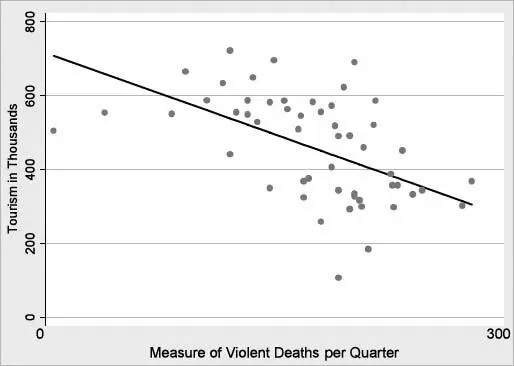
Clearly, more violence means a lot fewer tourists. In fact, on average, every violent death translates into 1,300 fewer tourists and 2,550 fewer hotel bed-nights sold to tourists. There were 53 violent deaths during the typical quarter covered here. That translates into nearly 70,000 fewer tourists in a three-month period suffering average violence compared to the number expected in quarters with no dispute-related violent deaths. Israel averages about 450,000 tourists per quarter, so 70,000 is a serious number. With Israel enjoying about $3 billion in tourist revenue in an average recent year, and an average year having about 280,000 fewer tourists than might conservatively be expected in a peaceful year, that translates into about $500 million tourist dollars lost each year, not counting whatever is also lost by hotels, restaurants, taxis, car rental companies, guides, and so forth on the Palestinian side of the border.
Читать дальше
